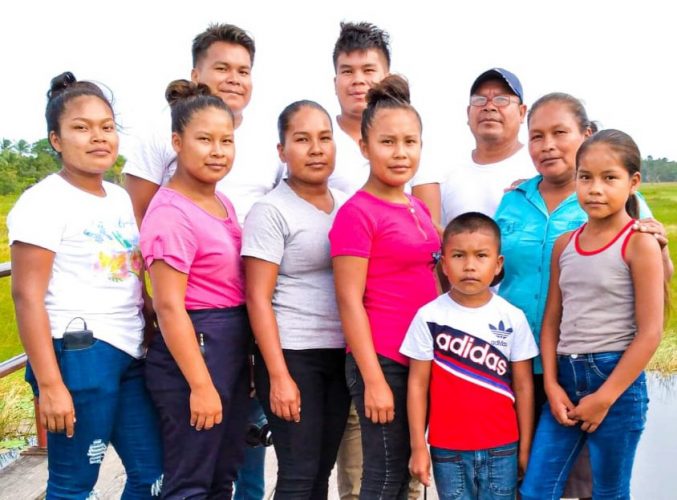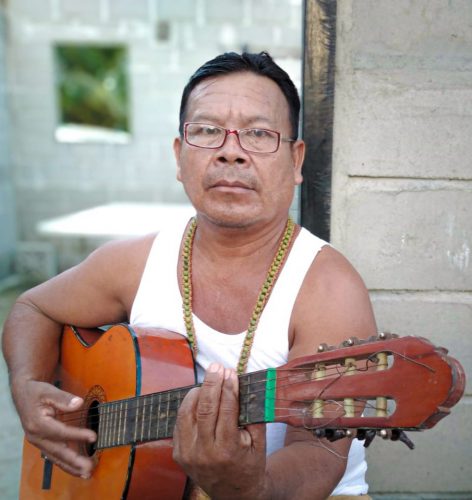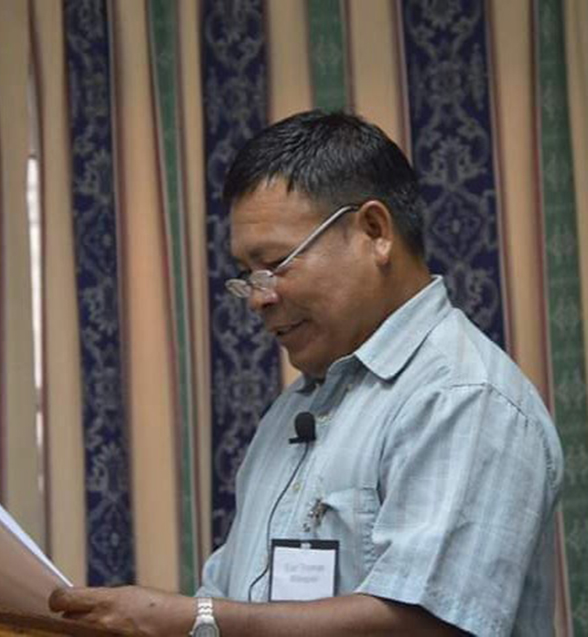Earl Montgomery Thomas, of St Lucian Mission, Wakapoa, in the Pomeroon River, Region Two had to reach rock bottom before he took control of his life.
Once an alcohol and narcotics addict, today he is a Seventh Day Baptist pastor, community and Indigenous Peoples activist, carpenter/joiner, musician, boat builder and a family man.
“I had to make drastic changes to my attitudes and behaviour,” Thomas, Secretary of the Amerindian Peoples Association (APA), said in an interview at Wapakao last month about his journey from his youth to the present day.

In the early 80s Thomas, after leaving the Wakapoa Primary School at 16 years, went to Charity to take part in an apprenticeship scheme to learn a skill with others his age at the then state-owned Guyconstruct at Charity on the Pomeroon River. “I had no formal secondary or tertiary education,” he said.
At Guyconstruct, the apprentices were coursed in the theoretical principles and practical knowledge of building construction, carpentry and joinery. On the completion of training, he and his batch mates were recommended to go to Parika or Lethem to work in state owned entities. “I did not go. I felt I was ready to go it alone. So, at Charity, I started working for myself but my start was not the best.”
During the apprenticeship period, he said, he was influenced by friends into smoking ganja and drinking alcohol. By age 19, he was an addict.
“In 1983, I went to Venezuela from Charity with a boat that was plying the contraband trade and transporting people.”
Although things were rough in Guyana, foodstuff and other commodities were reasonably cheap in Venezuela, he recalled.
“In Venezuela, I met up and made friends with the same kind I had at Charity. I continued smoking ganja and drinking to the point where I was losing my memory. I was so high that one day I could not find a bag that was within eyesight and I lost a lot of things. Some days I didn’t know anything.”
How did he change his behaviour? Thomas said, “There was a time when I came out of a high and found I had stitched my shirt onto my breast with a needle and thread. I called my older brother, who was also in Venezuela with me at the time, to bring a scissors and cut the stitches out. He told me that I was a mad man.” Thomas is the fourth child of 12 siblings.
At the time he stitched his shirt on his chest, he was about 25 years old. “I told myself I had to change. That I was killing myself. I had this conviction of heart that all I was doing was wrong. I wasn’t doing right. I found a church. I started going to the service…. I had to change. There in Venezuela, I started playing the guitar which I used to do in church at Wakapoa when I was growing up. Gospel music was in my head. I started to pray and fast to break the cycle of self-abuse. It wasn’t easy. I had to battle the strong desires of addiction.”

Today, he neither drinks nor smokes.
“In 1989, knowing that I was not doing right by myself, I decided to return home to settle. During the six years I was living in Venezuela I used to come home every now and again.”
On return to Guyana and with a changed outlook on life, Thomas started teaching to play the guitar to members of his Seventh Day Baptist Church. At the time the membership had dwindled for lack of a pastor or leader.
Looking back, he said, “I was young and I did not see myself as a leader. Anyway, I started to build the musical talent in the church through music and so my community activism began with the church.” Soon he became the deputy leader of the church.
Thomas, who is married, is the father of three sons and six daughters. He sings and writes his own songs. He, more or less, taught himself to play the guitar and keyboard and he has encouraged his entire family to become involved in music, song and dance. This includes traditional Amerindian music, song and dance. One of his sons also plays the guitar. “My family has its own dance group and we perform every year at our heritage celebrations. We have performed at several venues including Lake Mainstay, Charity, Anna Regina and Georgetown. We are a cultural family.”
Of the Lokono (Arawak) nation, Thomas’s dream, “is to see a cultural revival of the Lokono language reintroduced into our daily life. We are losing our language. I can speak the language but not as fluently as I would like to.”
People of the Carib and Warrau nations also live at Wakapao and a few of them also speak their languages. The village has a population of about 3,000.
Community and social activism
In the mid-90s, as deputy leader of his church, Thomas recalled the concerns a few villagers were expressing about a timber operation in which they had been employed. In spite of their earnings, they were getting deeper and deeper in debt with the owner of the operation. The owner had been granted permission to work on the village lands and to employ village labour.
“This was the first time I gave voice to the concerns of villagers. I questioned publicly, how was it, if the owner was paying so well and providing so much for his employees, the workers were not coming out of expenses with him? This sparked a discussion and the workmen began speaking out about what they were going through. Their concerns amounted to exploitation. They came to me as they felt that the village toshao and village council at the time were not representing them. I was just a church leader.”
When the time came for the renewal of the agreement of the timber operation, a meeting was held to discuss the issue of renewal. The meeting could not reach an agreement for the renewal of the contract as there were equal numbers for and against. The meeting agreed to take the matter to the regional authorities to advise on the way forward.
In the meantime, Thomas said, “the owner of the timber operation began to intimidate and threaten the workmen who owed him lots of money. He told them that if they didn’t pay up he was going to put them all in the lockups.”
Two weeks later the meeting with the regional administration officials, the village council and the employees was held at Wakapoa. “Against the wishes of many of the employees and villagers and with the support of the then toshao,” Thomas said, “The regional authorities directed the village council to renew the contract. In my view that was an imposition and it was not a good sign.”
Subsequently, a number of workmen returned to him for advice and he simply told them, “I don’t know what to do because, at the time, I just didn’t know what to do.”
When Yvonne Pearson, then official of the APA visited Wakapoa sometime later, he met with her and she advised that he send a letter with their concerns to the then Minister of Amerindian Affairs Carolyn Rodrigues-Birkett and copied to the Guyana Forestry Commission, Region Two administration and the APA. The letter was sent off with over 100 signatures.
“This was where I got the inspiration to take up community and social activism. That incident triggered all I have been doing since.”
In spite of the support he got from villagers, he said, “A lot of people started targeting me including some from the village council. The then CDO (community development officer) called me opposition and asked me to recant what I had been doing because she said, I was causing a lot of trouble in the village. The letter and copies had already been sent.” Eventually, with no action taken by the governmental authorities, Thomas said, the employees left the timber operation one by one and it was forced to close because of the lack of village labour.
After the letters were sent out, the APA invited Thomas to Georgetown to relate exactly what had been happening in the timber operation. He was able to gain more understanding about what had been taking place in Wakapoa and elsewhere.
“That incident with the timber operation and Wakapoa began my affiliation with the APA. After that I attended a number of training sessions organized by the APA on how to be a community leader and facilitator. I learnt a lot about local and constitutional laws, international laws, conventions and so forth pertaining to Indigenous Peoples. Some international conventions may not be binding but they provide a guide for what can be done.”
Since joining the APA, Thomas has served as its secretary for four terms. He first served two three-year terms and was not eligible for a third consecutive re-election. As such he served a three-year term as assistant secretary-treasurer after which he was elected again to another three year term as secretary. He is currently serving another second term in the second cycle after which he will not be eligible for reelection as secretary.
The training received in 2004 and 2005 as a facilitator for the revision of the Amerindian Act, which was passed in the Parliament in 2006, was especially an eye opener, he said. The training in 2004 was to conduct workshops in Indigenous Peoples communities, to help them understand the contents of the act and to help prepare them to make recommendations for inclusion or deletion of provisions in the act. The training for 2005 was to make people aware of the contents of the draft bill and to express their concerns. He travelled mostly to the communities in Regions One, Two and Nine and assisted in Regions Eight and Seven when it was necessary.
After becoming a pastor in 1999 and visiting a number of villages in Region Two, Thomas said, apart from church issues, residents of those villages and village leaders would ask for his advice on matters affecting them, including land issues. “I give advice based on what the law provides and advise on how they could go about solving their problems.”
At the village level, Thomas was elected a councilor twice. Once he ran for the position of toshao but in a community that is politically sensitive, he said, “I lost the toshao elections but I was still elected a councilor on the village council. I was branded an opposition. That does not stop councilors or the people coming to me for advice. I continue to work and support the council.”
COVID-19
As a pastor and influential member within his community and Thomas has now taken an active role in assisting in an awareness campaign to curb the spread of the dreaded COVID-19.
“The first case of the coronavirus was detected in the village on January 10. Since then we have had eight cases. The community has established a task force involving the village council, health centre, church and education department. As pastor I was tasked to meet with other pastors to enlist their help in spreading awareness of the coronavirus and what people needed to do to avoid contracting it and to stop the spread.”
Because of assistance provided by the APA, Thomas said, “I have been able to do house to house visits. Because of early pronouncements by some influential people, many people including church people do not believe that the virus is real. Some believe that because of their faith they are not susceptible. I have had to use my communications skills and the word of God, such as, citing the example of Job being a perfect man and he still got sick, to get them to understand that COVID-19 is a killer.”
“Because of the negative effects that COVID-19, religion and politics have in dividing the community,” he said, “I have been trying to get people to understand that religious differences calls for respect of people’s beliefs. Politics and political allegiances have been dividing the community and even families. We have to get past party politics because it is hindering development. Now we are seeing that COVID-19 is dividing the people. Some are trying to follow the health protocols to stay safe and some are not. Covid-19 does not discriminate. Everyone should be involved in protecting their loved ones despite their beliefs.”






